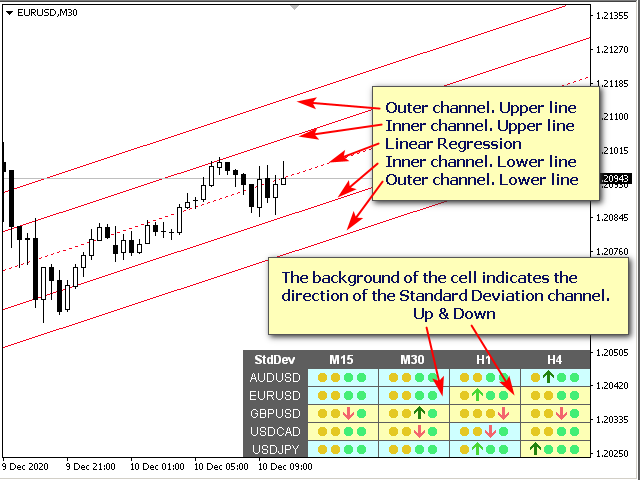Multi-currency and multi-time frame indicator of the Standard Deviation Channel. Displays the current market direction. On the panel you can see breakouts and touches (by price) of the levels of the linear regression channel. You can specify any desired currencies and periods in the parameters. The indicator can also send notifications when levels are touched. By clicking on the cell, this symbol and period will be opened.
“The Standard Deviation channel is based on a Linear Regression Trend, which is an ordinary trend line constructed between two points on a price chart using the least squares method. As a result, this line turns out to be the exact average line of the changing price. It can be considered as an “equilibrium” price line, and any deviation from it up or down indicates increased activity of buyers or sellers, respectively”
Parameters
Show Linear Regression on the chart — draw a Channel on the current chart.
Standard Deviation Channel
StartBar (0 – current bar) — the candle from which the calculation of linear regression will begin. Zero is the current bar, the regression will be updated on each tick.
Bars for Calculation — the number of candles to calculate.
[spoiler title=”Read More…”]
Inner Channel Multiplier — multiplier for building an inner channel.
Outer Channel Multiplier — a multiplier for building an external channel.
Dashboard
Clear the chart at startup — clear the chart at startup;
Set of Pairs — a set of characters
— Market Watch — pairs from the “Market Overview” window;
— Specified manually — the pairs specified manually in the “Pairs” parameters;
— Current pair — show only the current pair.
Pairs (separated by a space or semicolon) — a list of characters separated by a space or semicolon. Currency names should be written exactly the same as the broker’s, keeping the case and prefix suffix;
Time Frames (separated by a space or semicolon) — a list of timeframes separated by a space or semicolon;
Sort pairs — sorting the list of characters;
Position on chart — the angle of the panel on the chart;
X offset (pix) — move the panel along the X axis;
Y offset (pix) — move the panel along the Y axis;
Refresh dashboard every (seconds) — the refresh period of all symbols and timeframes;
Open the pair in a new window — open a new window for the chart by clicking;
Chart template — the name of the template for the chart, if the chart opens in a new window;
Code when cross from bottom to top (price above line) — the code of the symbol when the price touches the line from bottom to top;
Code when cross from top to bottom (price below line) — the code of the symbol when touched from top to bottom;
Code when no touch — the code of the symbol when there is no touch of the line;
Color when cross from bottom to top (price above line) — the color of the symbol when touched from bottom to top;
Color when cross from top to bottom (price below line) — the color of the symbol when touched from top to bottom;
Color when price is above line (no touch) — the color of the symbol when the price is above the line and there is no touch;
Color when price is below line (no touch) — the color of the symbol when the price is below the line and there is no touch;
Cell color when regressing up — the color of the cell when the channel is directed upwards. (maybe clrNONE);
Cell color when regressing down — the color of the cell when the channel is directed down. (maybe clrNONE);
Transparency (0-255) — panel transparency;
Font name — font name;
Font size — font size;
Alerts
Alert when channel direction changes — check for channel direction changes;
All timeframes are in the same direction — alert if all periods of the pair are in the same direction;
All pairs (one column) are in the same direction — alert if all pairs in one column have the same color;
Inner channel. Upper line touch — check the upper line of the inner channel;
Inner channel. Lower line touch — check the lower line of the inner channel;
Outer channel. Upper line touch — check the upper line of the external channel;
Outer channel. Lower line touch — check the lower line of the external channel;
Check alerts only when the candle is closed — check the intersection of lines only after the bar is closed;
Timeframes for alerts (separated by a space or semicolon) — a list of periods for which an alert will be sent (separated by a space or semicolon).
[/spoiler]





